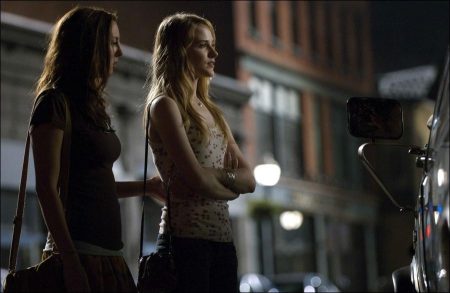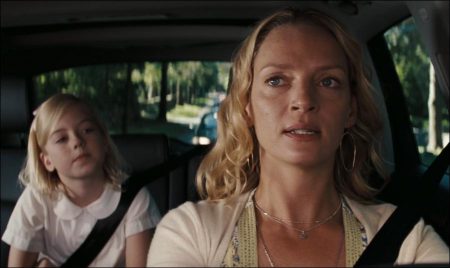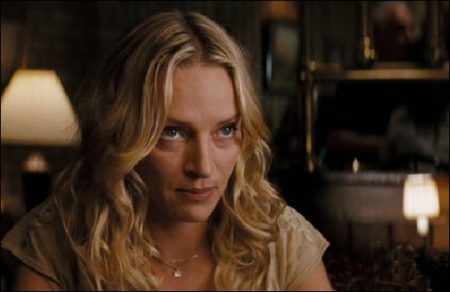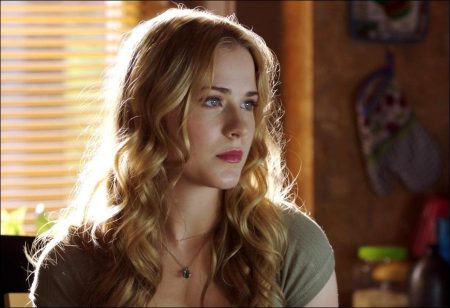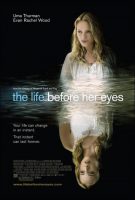All About The Life Before Her Eyes
The Life Before Her Eyes Movie Trailer. A core relationship for young Diana is her connection to her more conservative best friend Maureen, played by EVA AMURRI (The Banger Sisters, Saved). Vadim Perelman: “Young Diana is a rebel-she smokes, she’s always in trouble.
On the other hand, Maureen is more timid; she goes to church and she’s just discovering how to be an adult, whereas Diana is ahead of her in that respect…Both have been raised by single mothers who just can’t supervise them, so they have to rely on themselves and, as their friendship evolves, on each other.” The bond formed with Maureen and what happens in their desperate confrontation with the shooter continues to resonate in the way the older Diana lives her life.
Uma Thurman observes: “The film is really the dream of a young girl about what it will be like to grow up and get past everything she’s struggled with.” She sees the moment of choice as a watershed between now and then. “The movie is about the way life can go from bumbling along, where all you’re concerned about is your boyfriend and your mom and your homework and your grades-totally mundane stuff-and then some horrific tsunami of human anger can just tear through a community and destroy it.”
Defining the turning-point situation in emotional, not political terms, Perelman declares: “The Life Before Her Eyes is not a film about a school shooting. It’s about how the incident guides people’s characters and about how these characters find a way to reaffirm their own lives.”
Since the production depended on finding two actresses who could convincingly play the same character, casting the two Dianas was a central challenge. Perelman had been tracking Evan Rachel Wood since her first breakout film role: “Evan was 15 when I met with her after the premiere of her film Thirteen. I told her, `I have a film that would be perfect for you.’ She was always the young Diana for me.” Wood remained committed to the picture for over three years. Producer Peyronnet points out that the young actress turned down other films to honor her interest in The Life Before Her Eyes, “as if the film were written for her.”
The task then became finding the perfect choice to play adult Diana, someone who could capture the mystery of the character without losing the specific edges that make this woman alive and accessible. Perelman describes his first encounter with Thurman: “When I met Uma I really felt she had a depth of character. She’s a mother herself and has a real understanding of life that is important to portraying this character.” Uma Thurman found the script beautifully written, with a dream-like feel that “put you into a sort of trance.”
She finds a entry to adult Diana in the way trauma has formed her sensitivity-how she takes the fears that remain from her ordeal and projects them into her concern for her own daughter Emma (played by the exceptional Gabrielle Brennan). She says the essence of her job as an actress in this movie is “to play the emotional thrust of the character – a real woman remembering something and trying to work out her life with her husband and child.”
In calibrating the two actress’ performances so that audiences would believe that Thurman and Wood were playing the same character, Perelman found the giving of trust was a key tool: “First of all,” says Perelman, “Diana’s not my character any more. As soon as I give them the role, I relinquish it to them. And they become the vessel-all I can do is stand by.
and very gently steer them… Every day I would show both of them the dailies from the other’s performance. I wanted them to understand that they were really playing the same person. They both understood each other’s mannerisms and speech patterns-it looks like the most natural thing in the world but it took a lot of careful scrutiny.”
For Perelman, actress Eva Amurri wasn’t an obvious choice to play young Diana’s best friend Maureen. A child of the theater, daughter of Susan Sarandon and director Franco Amurri, Eva did not share Maureen’s aversion to risk or her natural quiet reserve: “She’s a self-assured, bubbly person. She’s not the meek, religious little girl at all. And I think that Eva’s true personality helped humanize Maureen. It gave her a kind of fire inside the character and highlights her heroism in this story.”
Evan Rachel Wood describes the interplay between young Diana and Maureen, “the free spirit” and “the good girl“: “They are complete opposites, but they somehow completely get each other.” She and Eva found that Perelman used their own growing on-set friendship to deepen the connection between the characters they play: “Sometimes Vadim wouldn’t even tell us the cameras were rolling and just let me and Eva go off and be ourselves.” Yet Perelman could be a tough taskmaster:
“He’s very blunt…I appreciate it because I’m hard on myself and it helps to have someone there obsessing over every little detail with you,” says Wood. Amurri concurs: “What Vadim does is very, very calculated. He knows exactly what he wants and he’s making the movie he wants to make every day. It’s really his baby.”
Thurman found the risk-taking theme extended to the decision to make the film itself: “I think there’s this real epidemic in cinema that nobody makes dramas any more. I love drama and so when I saw the boldness and bravura in House of Sand and Fog, I thought, `Here’s someone who said “I’m going to make a drama” and really did.” Produced and financed by Todd Wagner and Mark Cuban’s 2929 Productions (Good Night, and Good Luck; We Own the Night), The Life Before Her Eyes was the very epitome of an independent production. Says Thurman, “This is exactly what independent cinema is for, to do edgier material, to do it economically and smartly and to present it to the right audience. That’s how a complete vision can be created.”
Production Designer Maia Javan and Costumer Designer Hala Bahmet had worked with Vadim Perelman on House of Sand and Fog, while Director of Photography Pawel Edelman established his reputation on the international scene with Roman Polanski’s The Pianist, for which received an Oscar® nomination. He went on to film Taylor Hackford’s award-winning Ray. Together, these three formed the nucleus of Perelman’s creative crew, focusing on capturing the precise visuals and pervasive mood that the project demanded. Javan speaks of the director’s goal in having “an engaging contrast between the two time periods we are representing,” a difference that cannot be so pronounced as to throw the viewer out of the picture.
The world of the younger Diana has a warm, lush tone of remembered moments, a sense of classic richness like Vermeer, while the adult Diana’s life is portrayed in cooler tones that then grow more intense: “There’s a little bit more of a bright, vibrant, hyper-real springtime look that grows more extreme – abundant, mad, blossoming – as the fabric of her life starts to unravel.” These visual links need to be felt by the audience without having too much attention drawn. “We wanted to be very clever, but never appear clever.”
Although fifteen years separate the two time periods, it is always springtime in The Life Before Her Eyes. Yet even when the locations are the same, Evan Rachel Wood’s spring has to come across as different from Uma Thurman’s. Among the references Perelman brought to his visual team were macro nature photography, as well as highly saturated Japanese period photography.
The Connecticut locations were particularly valuable, because the places were fresh, yet steeped in history and character. Javan says: “We really found the landscape here. We were almost offered too many choices for what we wanted.” The only set built on this show was the school bathroom where the Diana / Maureen confrontation with shooter takes place. The set needed to have the real of a real place, but to allow for special effect, firearms, exploding sinks and a considerable amount of standing water. Mirrors were constructed to work two-way, so that the reflections would not betray the crew at work and multiple mirror images could capture an “infinity effect.”
“The set was lined on both sides,” Javan reveals, “ten feet wide with huge mirrors.” The dramatic action of The Life Before Her Eyes pivots on the suspense of what really goes on in this room; it was critically important for the Perelman and his creative team that the view we have of this action is as complex and as resonant as the dramatic fulcrum demands. Javan describes the bathroom set as “a real bridge – a portal between all the worlds of the film.”
Music plays a key role in integrating the emotional suspense of the story. Two-time Academy Award-winner James Horner had worked with Perelman on House of Sand and Fog, for which his music received an Oscar® nomination. Collaborating again on this new picture, Horner brings his vast range of experience in working with notable filmmakers in a wide range of projects to the challenges of a story that deals so deeply with issues of time and place and has a mystic component while never losing its basis in reality. The score builds upon complex elements of sound design, all targeted at drawing the audience deeper into the experiences of both Dianas, and into the way their viewpoints eventually overlap.
Vadim Perelman: “I wanted to make a film that was first and foremost, deeply rooted in reality. And then a horrific event shatters that reality. And the shards of it reflect something almost supernatural. The Life Before Her Eyes has classical elements of drama and it’s a mystery-an internal one. Usually movies that feature violence-like thrillers or police procedurals-they first diagnose the problem, develop an explanatory myth, and then rectify it. I wanted to make a movie where the reason for the violence was not the main question but rather, `What effect does the violence have on the people who go through it?’”
The Life Before Her Eyes (2008)
Directed by: Vadim Perelman
Starring: Uma Thurman, Evan Rachel Wood, Eva Amurri, Brett Cullen, Gabrielle Brennan, Lynn Cohen, Nathalie Paulding, Molly Price, Oliver Solomon, Anna Moore, Isabel Keating
Screenplay by: Emil Stern
Production Design by: Maia Javan
Cinematography by: Pawel Edelman
Film Editing by: David Baxter, David Baxter
Costume Design by: Hala Bahmet
Set Decoration by: Carol Silverman
Music by: James Horner
MPAA Rating: R for violent and disturbing content, language and brief drug use.
Distributed by: Magnolia Pictures
Release Date: April 18, 2008
Views: 134
